Coupled Atmosphere–Fire Modelling of Pyroconvective Activity in Portugal
Abstract
1. Introduction
2. Data and Methods
2.1. The WRF-SFIRE Coupled Atmosphere–Fire Model
2.2. Model Setup
2.3. Observational Data
2.4. Moisture and Vertical Stability Assessment
3. Results and Discussion
3.1. Background Meteorology
3.2. Large Scale Model Results
3.3. Surface Weather Analysis
3.4. Model Sounding Analysis
3.5. Thermodynamics of the Plume
3.5.1. Fire Circulation’s Effect on the LLJ and Plume Geometry
3.5.2. Thermal Differences Between Fire and No-Fire Simulations
3.5.3. The Effect of Fire on Atmospheric Stability and Water Vapour Transport
3.5.4. Composition of the Simulated Pyroconvective Clouds
3.5.5. Fire Heat Fluxes Effect on Pyroconvective Cloud Formation
3.6. Impacts of Simulation Setup on Potential Fire Spread
4. Conclusions
Author Contributions
Funding
Data Availability Statement
Acknowledgments
Conflicts of Interest
Appendix A
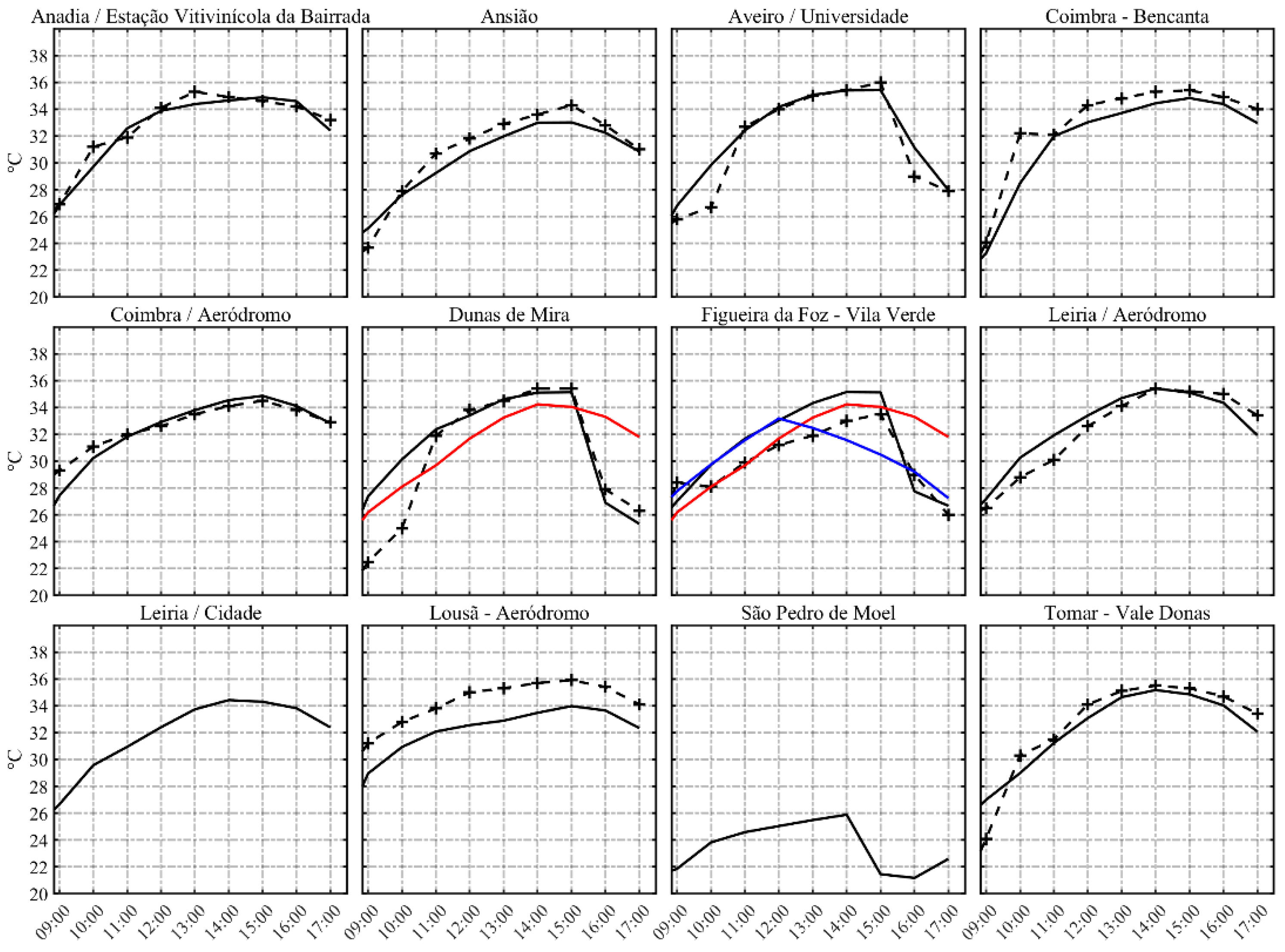
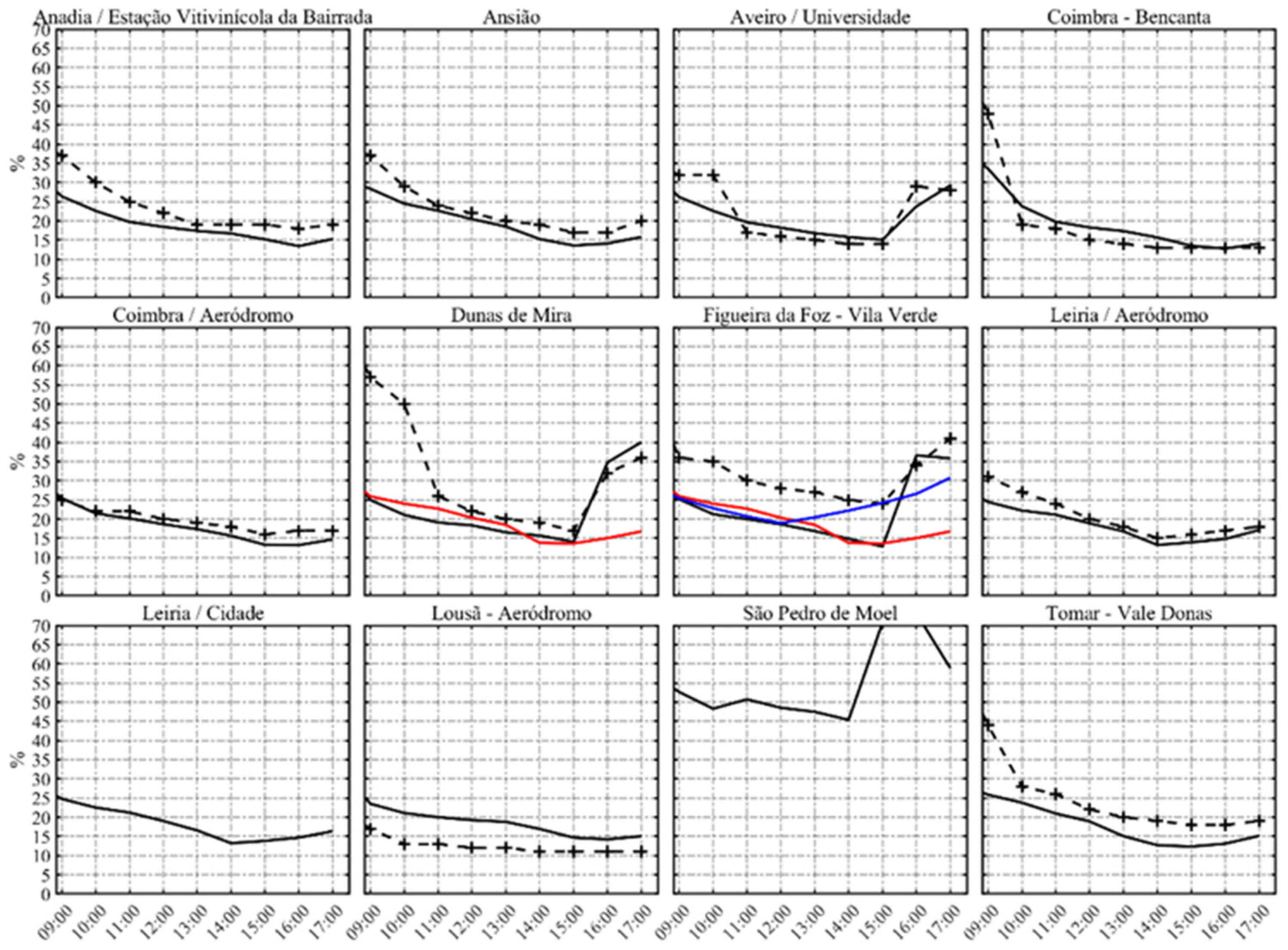
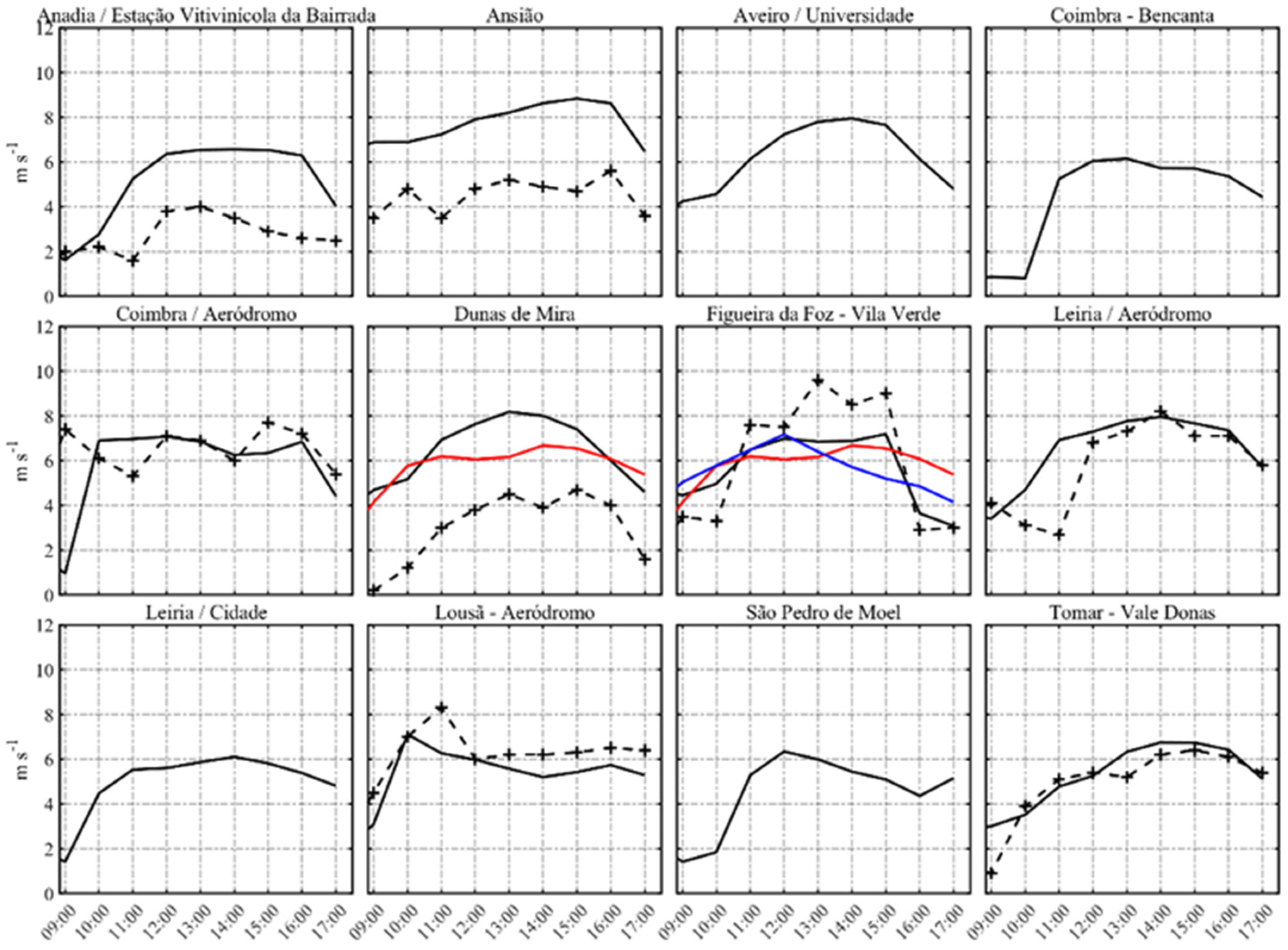
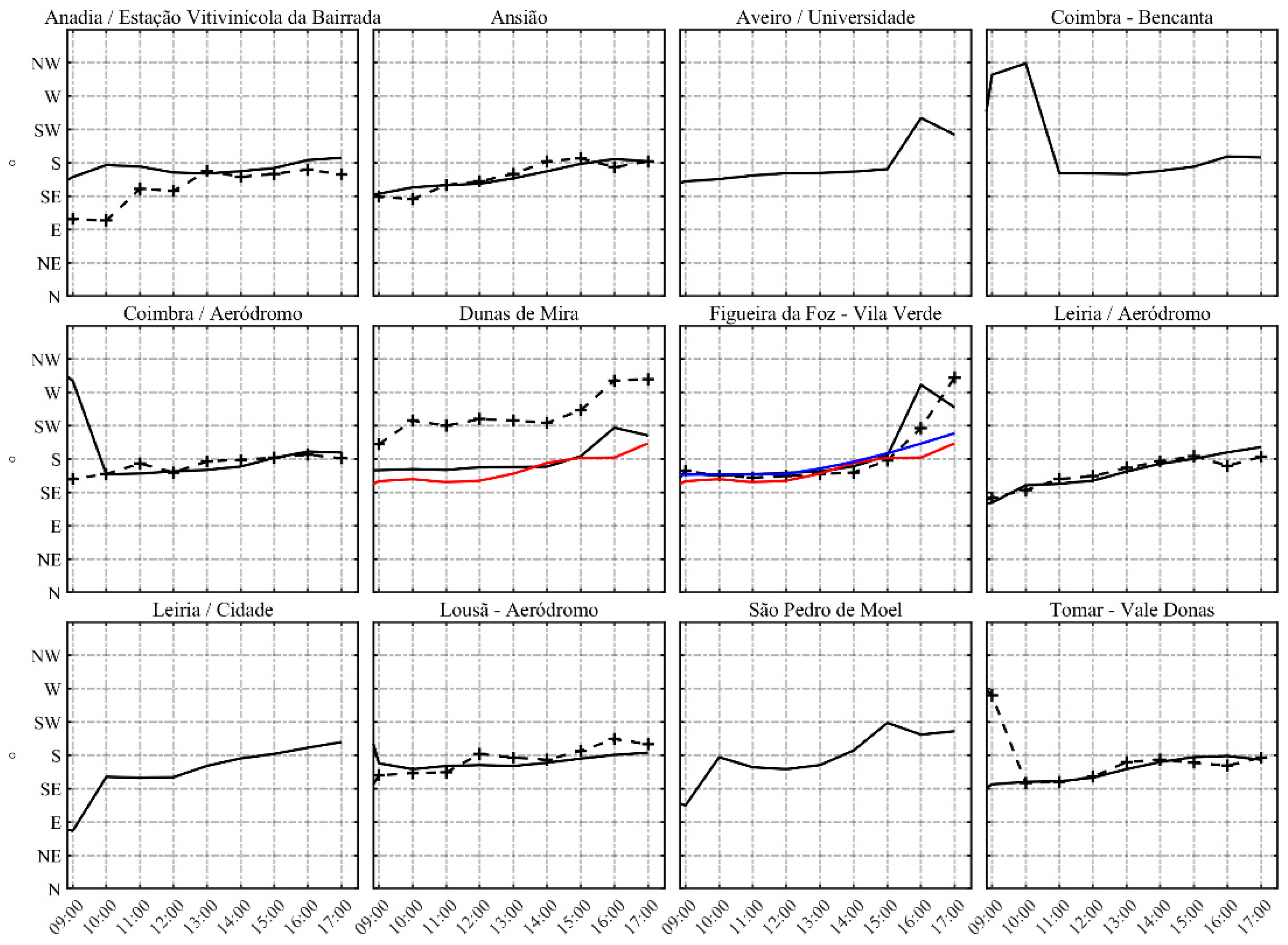

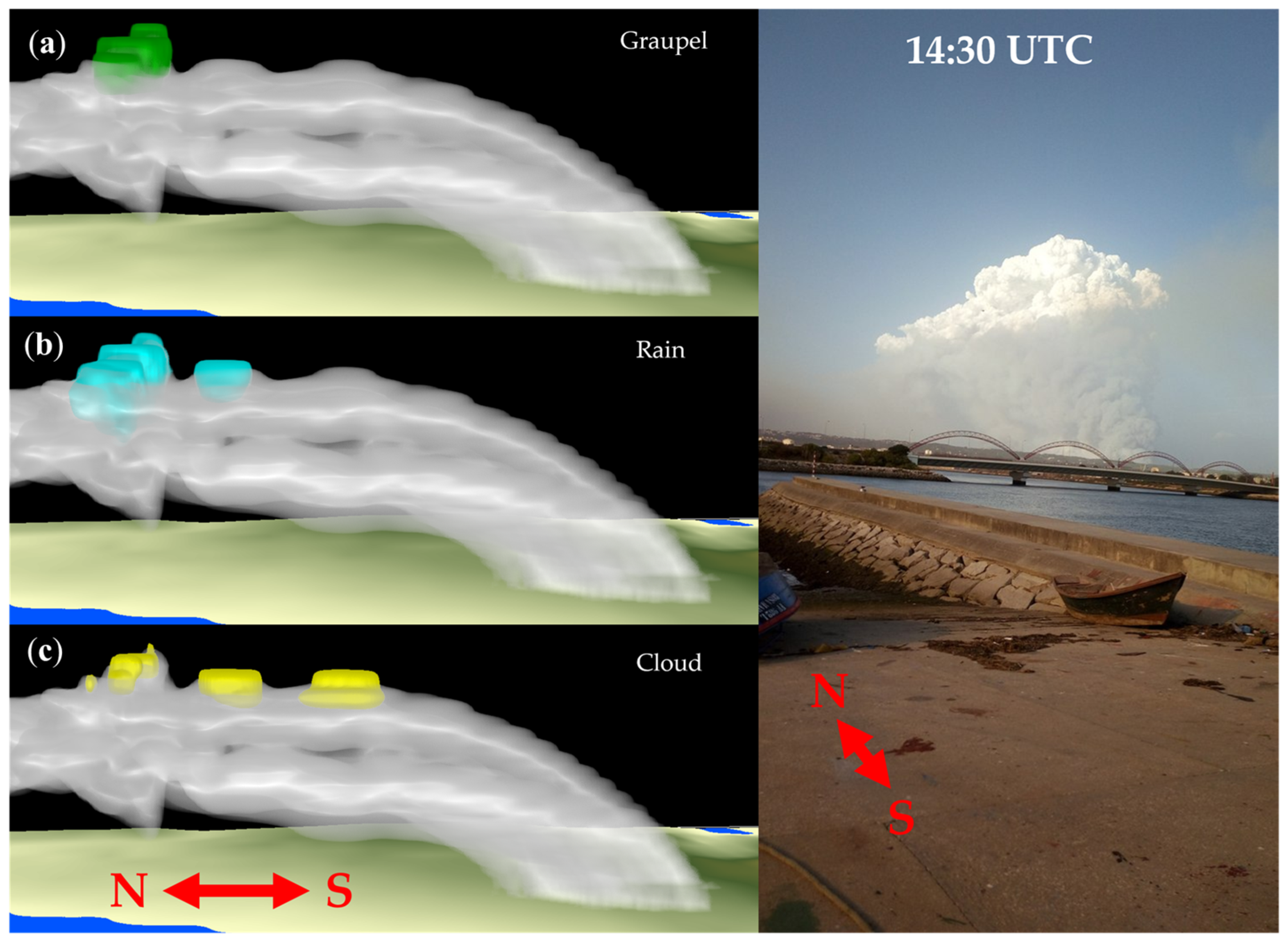
References
- American Meteorological Society. Pyrocumulus. In Glossary of Meteorology. 2024. Available online: https://glossary.ametsoc.org/wiki/Pyrocumulus (accessed on 26 March 2025).
- American Meteorological Society. Pyrocumulonimbus. In Glossary of Meteorology. 2024. Available online: https://glossary.ametsoc.org/wiki/Pyrocumulonimbus (accessed on 26 March 2025).
- Potter, B.E. Atmospheric Interactions with Wildland Fire Behaviour—I. Basic Surface Interactions, Vertical Profiles and Synoptic Structures. Int. J. Wildland Fire 2012, 21, 779. [Google Scholar] [CrossRef]
- Allen, C.D.; Macalady, A.K.; Chenchouni, H.; Bachelet, D.; McDowell, N.; Vennetier, M.; Kitzberger, T.; Rigling, A.; Breshears, D.D.; Hogg, E.H.; et al. A Global Overview of Drought and Heat-Induced Tree Mortality Reveals Emerging Climate Change Risks for Forests. For. Ecol. Manag. 2010, 259, 660–684. [Google Scholar] [CrossRef]
- Bugmann, H.; Palahi, M.; Bontemps, H.D.; Tome, M. Trends in Modeling to Address Forest Management and Environmental Challenges in Europe: Introduction. For. Syst. 2010, 19, 3–7. [Google Scholar] [CrossRef]
- Moritz, M.A.; Morais, M.E.; Summerell, L.A.; Carlson, J.M.; Doyle, J. Wildfires, Complexity, and Highly Optimized Tolerance. Proc. Natl. Acad. Sci. USA 2005, 102, 17912–17917. [Google Scholar] [CrossRef] [PubMed]
- Senande-Rivera, M.; Insua-Costa, D.; Miguez-Macho, G. Spatial and Temporal Expansion of Global Wildland Fire Activity in Response to Climate Change. Nat. Commun. 2022, 13, 1208. [Google Scholar] [CrossRef] [PubMed]
- Luderer, G.; Trentmann, J.; Andreae, M.O. A New Look at the Role of Fire-Released Moisture on the Dynamics of Atmospheric Pyro-Convection. Int. J. Wildland Fire 2009, 18, 554. [Google Scholar] [CrossRef]
- Tory, K.J.; Thurston, W.; Kepert, J.D. Thermodynamics of Pyrocumulus: A Conceptual Study. Mon. Weather Rev. 2018, 146, 2579–2598. [Google Scholar] [CrossRef]
- Potter, B.E. The Role of Released Moisture in the Atmospheric Dynamics Associated with Wildland Fires. Int. J. Wildland Fire 2005, 14, 77. [Google Scholar] [CrossRef]
- Fromm, M.; Lindsey, D.T.; Servranckx, R.; Yue, G.; Trickl, T.; Sica, R.; Doucet, P.; Godin-Beekmann, S. The Untold Story of Pyrocumulonimbus. Bull. Amer. Meteor. Soc. 2010, 91, 1193–1210. [Google Scholar] [CrossRef]
- Castellnou, M.; Bachfischer, M.; Miralles, M.; Ruiz, B.; Stoof, C.R.; Vilà-Guerau De Arellano, J. Pyroconvection Classification Based on Atmospheric Vertical Profiling Correlation With Extreme Fire Spread Observations. JGR Atmos. 2022, 127, e2022JD036920. [Google Scholar] [CrossRef]
- Luderer, G.; Trentmann, J.; Winterrath, T.; Textor, C.; Herzog, M.; Graf, H.F.; Andreae, M.O. Modeling of Biomass Smoke Injection into the Lower Stratosphere by a Large Forest Fire (Part II): Sensitivity Studies. Atmos. Chem. Phys. 2006, 6, 5261–5277. [Google Scholar] [CrossRef]
- Peterson, D.A.; Hyer, E.J.; Campbell, J.R.; Solbrig, J.E.; Fromm, M.D. A Conceptual Model for Development of Intense Pyrocumulonimbus in Western North America. Mon. Weather Rev. 2017, 145, 2235–2255. [Google Scholar] [CrossRef]
- Thurston, W.; Tory, K.J.; Fawcett, R.; Kepert, J.D. Large-Eddy Simulations of Pyro-Convection and Its Sensitivity to Environmental Conditions. In Proceedings of the Research Proceedings, Bushfire and Natural Hazards CRC & AFAC 2015 Conference’, Bushfire and Natural Hazards CRC, Adelaide, Australia, 1–3 September 2015; pp. 148–160. [Google Scholar]
- Tory, K.; Thurston, W. Pyrocumulonimbus: A Literature Review; Bushfire and Natural Hazards CRC: East Melbourne, Australia, 2015. [Google Scholar]
- Wakimoto, R.M. Forecasting Dry Microburst Activity over the High Plains. Mon. Wea. Rev. 1985, 113, 1131–1143. [Google Scholar] [CrossRef]
- Tory, K.J.; Kepert, J.D. Pyrocumulonimbus Firepower Threshold: Assessing the Atmospheric Potential for pyroCb. Weather Forecast. 2021, 36, 439–456. [Google Scholar] [CrossRef]
- Bakhshaii, A.; Johnson, E.A. A Review of a New Generation of Wildfire–Atmosphere Modeling. Can. J. For. Res. 2019, 49, 565–574. [Google Scholar] [CrossRef]
- Peace, M.; Greenslade, J.; Ye, H.; Kepert, J.D. Simulations of the Waroona Fire Using the Coupled Atmosphere–Fire Model ACCESS-Fire. J. South. Hemisph. Earth Syst. Sci. 2022, 72, 126–138. [Google Scholar] [CrossRef]
- Trentmann, J.; Luderer, G.; Winterrath, T.; Fromm, M.D.; Servranckx, R.; Textor, C.; Herzog, M.; Graf, H.-F.; Andreae, M.O. Modeling of Biomass Smoke Injection into the Lower Stratosphere by a Large Forest Fire (Part I): Reference Simulation. Atmos. Chem. Phys. 2006, 6, 5247–5260. [Google Scholar] [CrossRef]
- Kochanski, A.K.; Jenkins, M.A.; Yedinak, K.; Mandel, J.; Beezley, J.; Lamb, B. Toward an Integrated System for Fire, Smoke and Air Quality Simulations. Int. J. Wildland Fire 2016, 25, 534. [Google Scholar] [CrossRef]
- San-Miguel-Ayanz, J.; Durrant, T.; Boca, R.; Maianti, P.; Libertà, G.; Artés Vivancos, T.; Oom, D.; Branco, A.; Tomàs Rigo, D.; Ferrari, D.; et al. Forest Fires in Europe, Middle East and North Africa 2020; Publications Office of the European Union: Luxembourg, 2021; ISBN 978-92-76-42351-5. [Google Scholar]
- Hoinka, K.P.; Carvalho, A.; Miranda, A.I. Regional-Scale Weather Patterns and Wildland Fires in Central Portugal. Int. J. Wildland Fire 2009, 18, 36. [Google Scholar] [CrossRef]
- Parente, J.; Pereira, M.G.; Amraoui, M.; Fischer, E.M. Heat Waves in Portugal: Current Regime, Changes in Future Climate and Impacts on Extreme Wildfires. Sci. Total Environ. 2018, 631–632, 534–549. [Google Scholar] [CrossRef]
- Ermitão, T.; Páscoa, P.; Trigo, I.; Alonso, C.; Gouveia, C. Mapping the Most Susceptible Regions to Fire in Portugal. Fire 2023, 6, 254. [Google Scholar] [CrossRef]
- Aparício, B.A.; Alcasena, F.; Ager, A.; Chung, W.; Pereira, J.M.C.; Sá, A.C.L. Evaluating Priority Locations and Potential Benefits for Building a Nation-Wide Fuel Break Network in Portugal. J. Environ. Manag. 2022, 320, 115920. [Google Scholar] [CrossRef]
- 8.o Relatório Provisório De Incêndios Rurais 2024; Direção Nacional de Gestão do Programa de Fogos Rurais: Lisbon, Portugal, 2024; p. 14.
- Guerreiro, J.; Fonseca, C.; Salgueiro, A.; Fernandes, P.; Lopez, E.; de Neufville, R.; Mateus, F.; Castellnou, M.; Silva, J.S.; Moura, J.; et al. Análise e Apuramento Dos Factos Relativos Aos Incêndios Que Ocorreram Em Pedrogão Grande. In Castanheira De Pera Ansião Alvaiázere Figueiró Dos Vinhos Arganil Góis Penela Pampilhosa Da Serra Oleiros E Sertã Entre; Assembleia da República: Lisbon, Portugal, 2017; Volume 17. [Google Scholar]
- Ramos, A.M.; Russo, A.; DaCamara, C.C.; Nunes, S.; Sousa, P.; Soares, P.M.M.; Lima, M.M.; Hurduc, A.; Trigo, R.M. The Compound Event That Triggered the Destructive Fires of October 2017 in Portugal. iScience 2023, 26, 106141. [Google Scholar] [CrossRef]
- Viegas, D.X.; Almeida, M.F.; Ribeiro, L.M.; Raposo, J.; Viegas, M.T.; Oliveira, R.; Alves, D.; Pinto, C.; Rodrigues, A.; Ribeiro, C.; et al. Análise Dos Incêndios Florestais Ocorridos a 15 de Outubro de 2017; Centro de Estudos sobre Incêndios Florestais (CEIF/ADAI/LAETA): Coimbra, Portugal, 2019. [Google Scholar]
- Castellnou, M.; Guiomar, N.; Rego, F.; Fernandes, P.M. Fire growth patterns in the 2017 mega fire episode of October 15, central Portugal. In Advances in Forest Fire Research 2018; Imprensa da Universidade de Coimbra: Coimbra, Portugal, 2018; pp. 447–453. ISBN 978-989-26-1650-6. [Google Scholar]
- Campos, C.; Couto, F.T.; Filippi, J.-B.; Baggio, R.; Salgado, R. Modelling Pyro-Convection Phenomenon during a Mega-Fire Event in Portugal. Atmos. Res. 2023, 290, 106776. [Google Scholar] [CrossRef]
- Couto, F.; Salgado, R.; Filippi, J.-B.; Baggio, R.; Kartsios, S.; Cardoso, R.; Soares, P.; Campos, C. Intercomparação de Simulações Numéricas Com Modelos Atmosféricos Acoplados a Modelos de Propagação de Fogo. Rep. I 2023, 1, 1. [Google Scholar]
- Mandel, J.; Amram, S.; Beezley, J.D.; Kelman, G.; Kochanski, A.K.; Kondratenko, V.Y.; Lynn, B.H.; Regev, B.; Vejmelka, M. Recent Advances and Applications of WRF–SFIRE. Nat. Hazards Earth Syst. Sci. 2014, 14, 2829–2845. [Google Scholar] [CrossRef]
- Mandel, J.; Beezley, J.D.; Kochanski, A.K. Coupled Atmosphere-Wildland Fire Modeling with WRF 3.3 and SFIRE 2011. Geosci. Model Dev. 2011, 4, 591–610. [Google Scholar] [CrossRef]
- Skamarock, W.C.; Klemp, J.B.; Dudhia, J.; Gill, D.O.; Liu, Z.; Berner, J.; Wang, W.; Powers, J.G.; Duda, M.G.; Barker, D.M.; et al. A Description of the Advanced Research WRF Model Version 4; UCAR/NCAR: Boulder, CO, USA, 2019. [Google Scholar]
- Simões, I.; Pinto, P.; Silva, Á.; Pereira, M.; Barroso, C.; Santos, M.; Lopes, M.; Moreira, N.; Correira, S. Os Incêndios Florestais de 14 a 16 de Outubro de 2017 Em Portugal Continental; IPMA: Albany, NY, USA, 2018. [Google Scholar]
- Fozaominuto, Incêndios No Concelho Da Figueira Da Foz: Quiaios e Paião. Available online: https://www.fozaominuto.com/2017/10/incendios-no-concelho-da-figueira-da_15.html (accessed on 26 March 2025).
- Osher, S.; Fedkiw, R.P. Level Set Methods and Dynamic Implicit Surfaces; Springer: New York, NY, USA, 2003; ISBN 978-0-387-22746-7. [Google Scholar]
- Rothermel, R.C. A Mathematical Model for Predicting Fire Spread in Wildland Fuels; Intermountain Forest & Range Experiment Station, Forest Service, US Department of Agriculture: Ogden, UT, USA, 1972; Volume 115.
- Albini, F.A. Estimating Wildfire Behavior and Effects; Department of Agriculture, Forest Service, Intermountain Forest and Range Experiment Station: Ogden, UT, USA, 1976; Volume 30.
- Anderson, H. Aids to Determining Fuel Models for Estimating Fire Behavior. General Technical Report INT-122; US Department of Agriculture Forest Service, Intermountain Forest and Range Experiment Station: Ogden, UT, USA, 1982.
- Hersbach, H.; Bell, B.; Berrisford, P.; Hirahara, S.; Horányi, A.; Muñoz-Sabater, J.; Nicolas, J.; Peubey, C.; Radu, R.; Schepers, D.; et al. The ERA5 Global Reanalysis. Quart J. R. Meteoro Soc. 2020, 146, 1999–2049. [Google Scholar] [CrossRef]
- Hong, S.-Y. Hongandlim-JKMS-2006. J. Korean Meteorol. Soc. 2006, 42, 129. [Google Scholar]
- Kain, J.S. The Kain–Fritsch Convective Parameterization: An Update. J. Appl. Meteor. 2004, 43, 170–181. [Google Scholar] [CrossRef]
- Iacono, M.J.; Delamere, J.S.; Mlawer, E.J.; Shephard, M.W.; Clough, S.A.; Collins, W.D. Radiative Forcing by Long-lived Greenhouse Gases: Calculations with the AER Radiative Transfer Models. J. Geophys. Res. 2008, 113, 2008JD009944. [Google Scholar] [CrossRef]
- Hong, S.-Y.; Noh, Y.; Dudhia, J. A New Vertical Diffusion Package with an Explicit Treatment of Entrainment Processes. Mon. Weather Rev. 2006, 134, 2318–2341. [Google Scholar] [CrossRef]
- Niu, G.-Y.; Yang, Z.-L.; Mitchell, K.E.; Chen, F.; Ek, M.B.; Barlage, M.; Kumar, A.; Manning, K.; Niyogi, D.; Rosero, E.; et al. The Community Noah Land Surface Model with Multiparameterization Options (Noah-MP): 1. Model Description and Evaluation with Local-Scale Measurements. J. Geophys. Res. 2011, 116, D12109. [Google Scholar] [CrossRef]
- Yang, Z.-L.; Niu, G.-Y.; Mitchell, K.E.; Chen, F.; Ek, M.B.; Barlage, M.; Longuevergne, L.; Manning, K.; Niyogi, D.; Tewari, M.; et al. The Community Noah Land Surface Model with Multiparameterization Options (Noah-MP): 2. Evaluation over Global River Basins. J. Geophys. Res. 2011, 116, D12110. [Google Scholar] [CrossRef]
- De Meij, A.; Vinuesa, J.F. Impact of SRTM and Corine Land Cover Data on Meteorological Parameters Using WRF. Atmos. Res. 2014, 143, 351–370. [Google Scholar] [CrossRef]
- Jee, J.-B.; Kim, S. Sensitivity Study on High-Resolution Numerical Modeling of Static Topographic Data. Atmosphere 2016, 7, 86. [Google Scholar] [CrossRef]
- Jiménez-Esteve, B.; Udina, M.; Soler, M.R.; Pepin, N.; Miró, J.R. Land Use and Topography Influence in a Complex Terrain Area: A High Resolution Mesoscale Modelling Study over the Eastern Pyrenees Using the WRF Model. Atmos. Res. 2018, 202, 49–62. [Google Scholar] [CrossRef]
- OpenTopography, Shuttle Radar Topography Mission (SRTM) Global. 2013. Available online: https://opentopography.org/meta/OT.042013.4326.1 (accessed on 26 March 2025).
- European Environment Agency. CORINE Land Cover 2012 (Raster 100 m), Europe, 6-Yearly—Version 2020_20u1. May 2020. Available online: https://sdi.eea.europa.eu/catalogue/copernicus/api/records/a84ae124-c5c5-4577-8e10-511bfe55cc0d?language=all (accessed on 26 March 2025).
- Pineda, N.; Jorba, O.; Jorge, J.; Baldasano, J.M. Using NOAA AVHRR and SPOT VGT Data to Estimate Surface Parameters: Application to a Mesoscale Meteorological Model. Int. J. Remote Sens. 2004, 25, 129–143. [Google Scholar] [CrossRef]
- Copernicus Land Monitoring Service EU-DEM v1.1 2016. Available online: https://land.copernicus.eu/imagery-in-situ/eu-dem (accessed on 26 March 2025).
- Benali, A.; Guiomar, N.; Gonçalves, H.; Mota, B.; Silva, F.; Fernandes, P.M.; Mota, C.; Penha, A.; Santos, J.; Pereira, J.M.C.; et al. The Portuguese Large Wildfire Spread Database (PT-FireSprd). Earth Syst. Sci. Data 2023, 15, 3791–3818. [Google Scholar] [CrossRef]
- Copernicus Climate Change Service. In Situ Observations of Meteorological Variables from the Integrated Global Radiosounding Archive and the Radiosounding Harmonization Dataset from 1978 Onward. 2021. Available online: https://cds.climate.copernicus.eu/datasets/insitu-observations-igra-baseline-network?tab=overview (accessed on 26 March 2025).
- Brown, D.; Brownrigg, R.; Haley, M.; Huang, W. NCAR Command Language (NCL). 2012. Available online: https://www.unidata.ucar.edu/software/netcdf/workshops/2012/third_party/NCL.html (accessed on 26 March 2025).
- Zhang, Y.; Gao, Z.; Li, D.; Li, Y.; Zhang, N.; Zhao, X.; Chen, J. On the Computation of Planetary Boundary-Layer Height Using the Bulk Richardson Number Method. Geosci. Model Dev. 2014, 7, 2599–2611. [Google Scholar] [CrossRef]
- Stewart, S. National Hurricane Center Tropical Cyclone Report: Hurricane Ophelia (AL172017); Tech. rep.; NOAA: National Hurrican Center: Miami, FL, USA, 2018.
- Stull, R.B. Mean Boundary Layer Characteristics. In An Introduction to Boundary Layer Meteorology; Springer: Berlin/Heidelberg, Germany, 1988; pp. 1–27. [Google Scholar]
- Carvalho, D.; Rocha, A.; Gómez-Gesteira, M.; Santos, C. A Sensitivity Study of the WRF Model in Wind Simulation for an Area of High Wind Energy. Environ. Model. Softw. 2012, 33, 23–34. [Google Scholar] [CrossRef]
- Potter, B.E. A Dynamics Based View of Atmosphere—Fire Interactions. Int. J. Wildland Fire 2002, 11, 247. [Google Scholar] [CrossRef]
- Barrett, A.I.; Wellmann, C.; Seifert, A.; Hoose, C.; Vogel, B.; Kunz, M. One Step at a Time: How Model Time Step Significantly Affects Convection-Permitting Simulations. J. Adv. Model Earth Syst. 2019, 11, 641–658. [Google Scholar] [CrossRef]

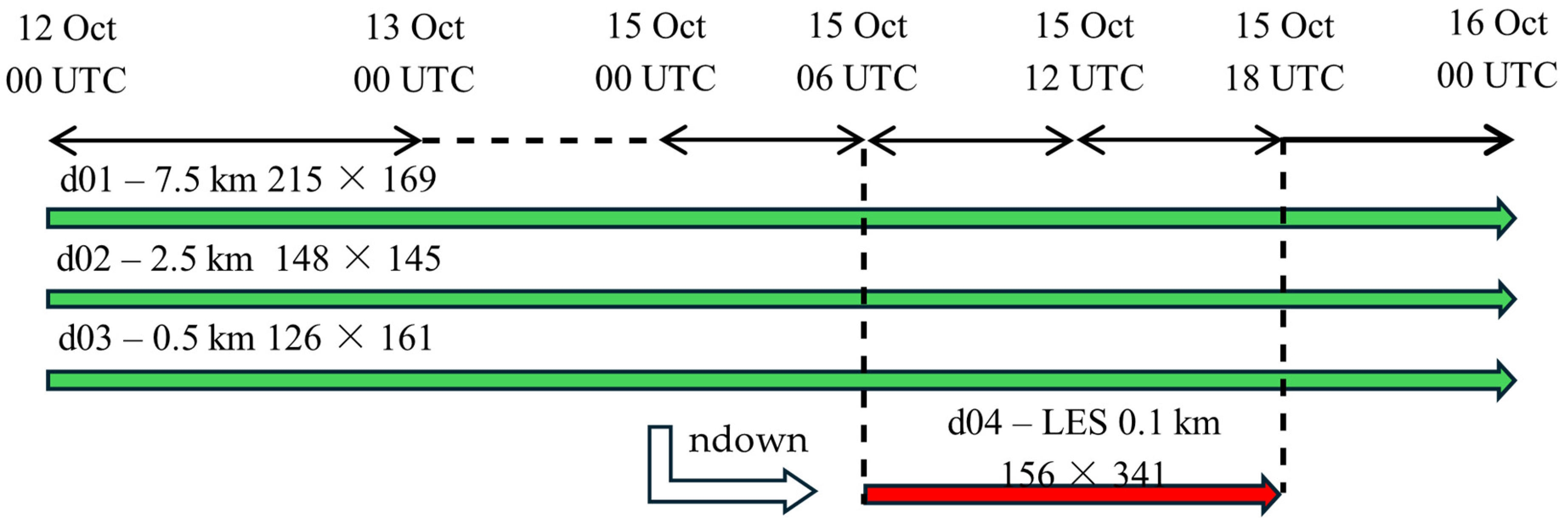



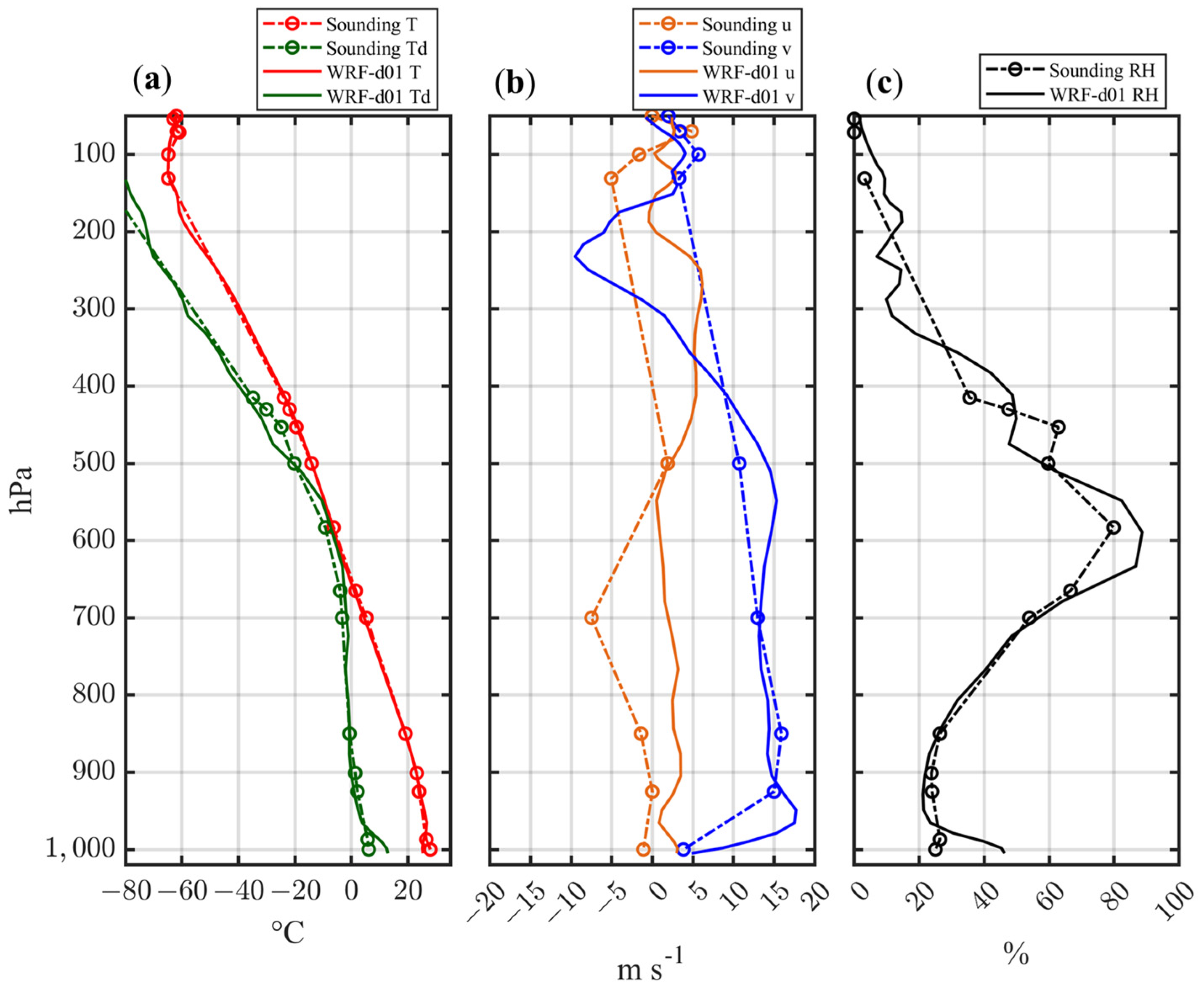


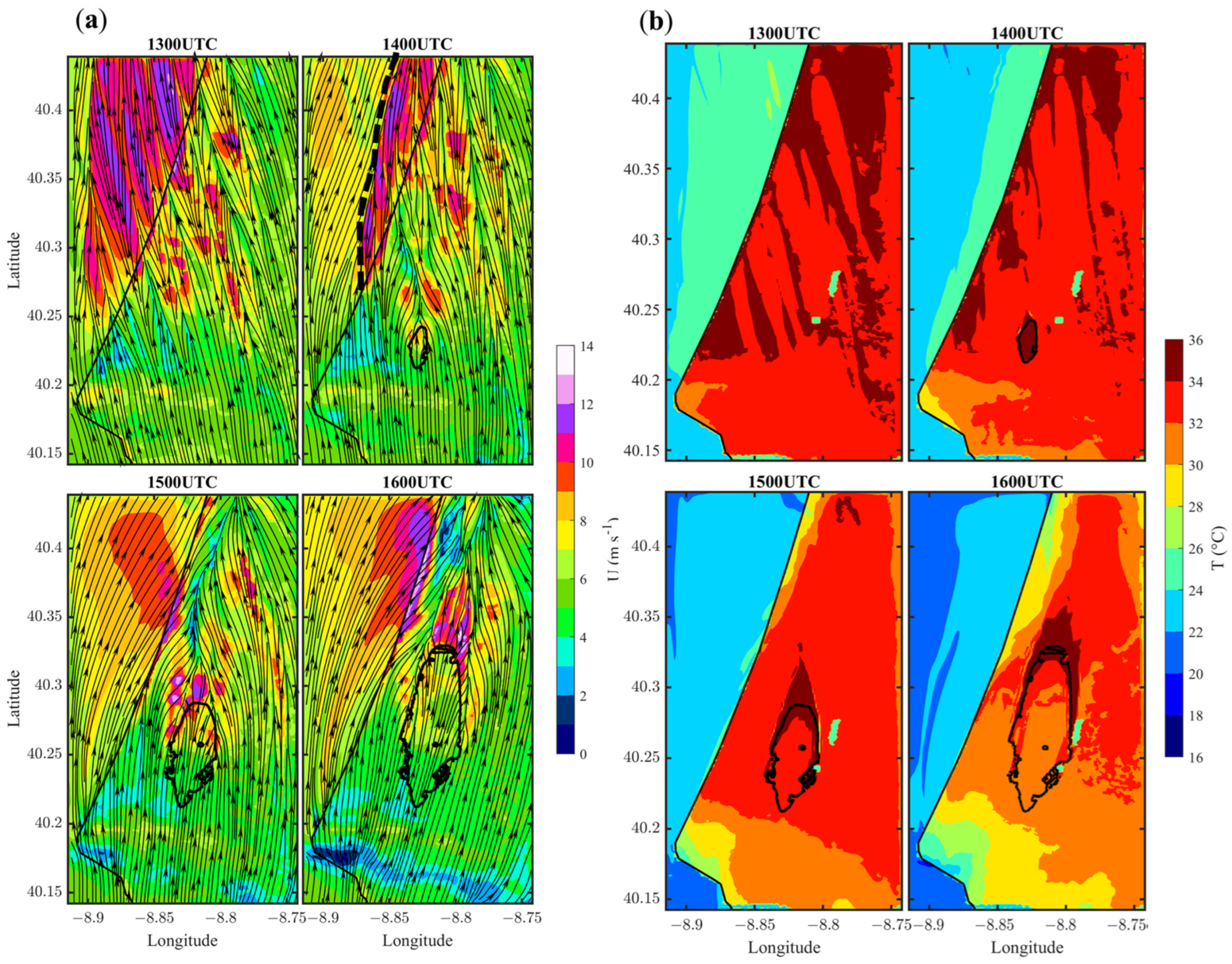

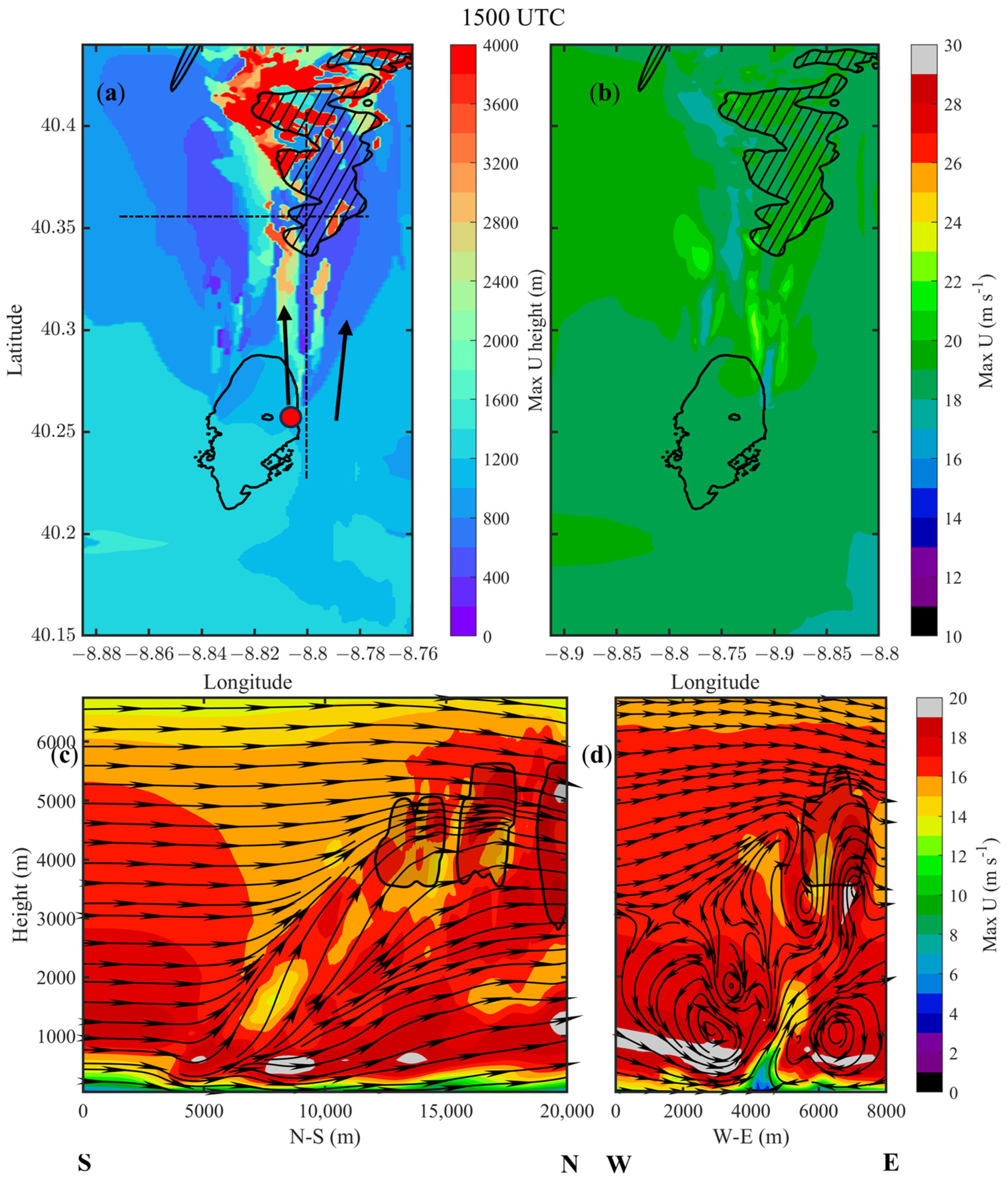

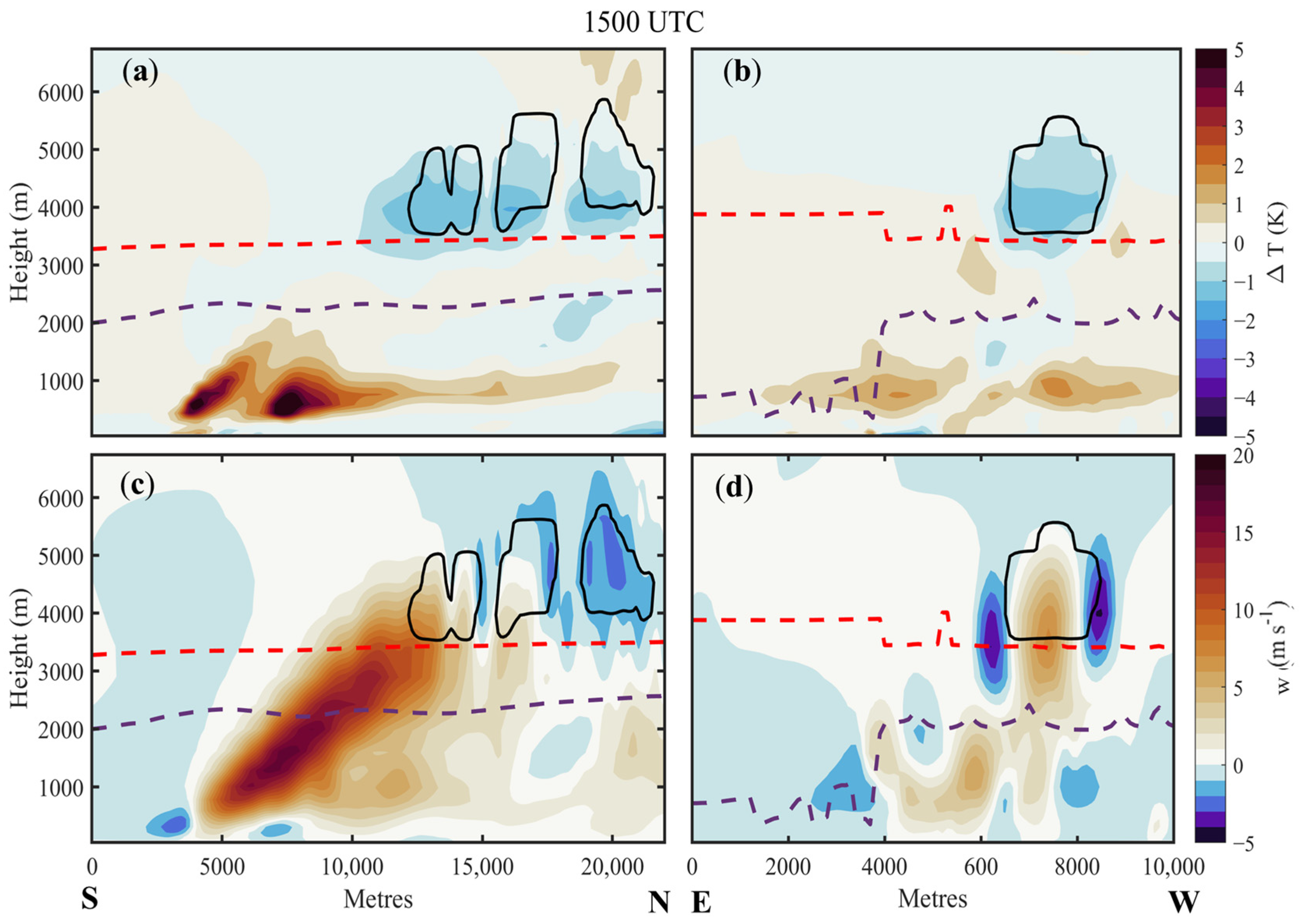
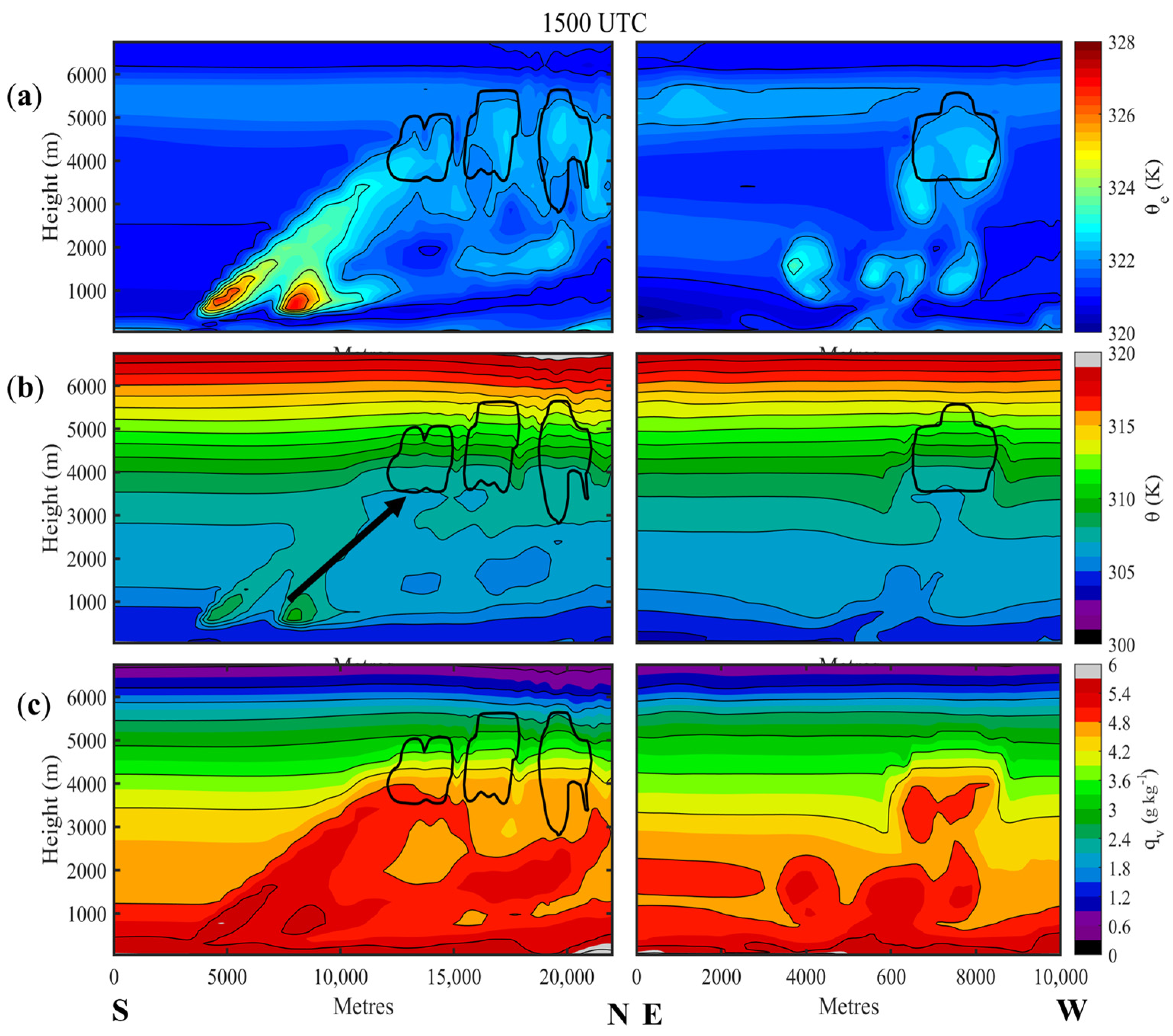

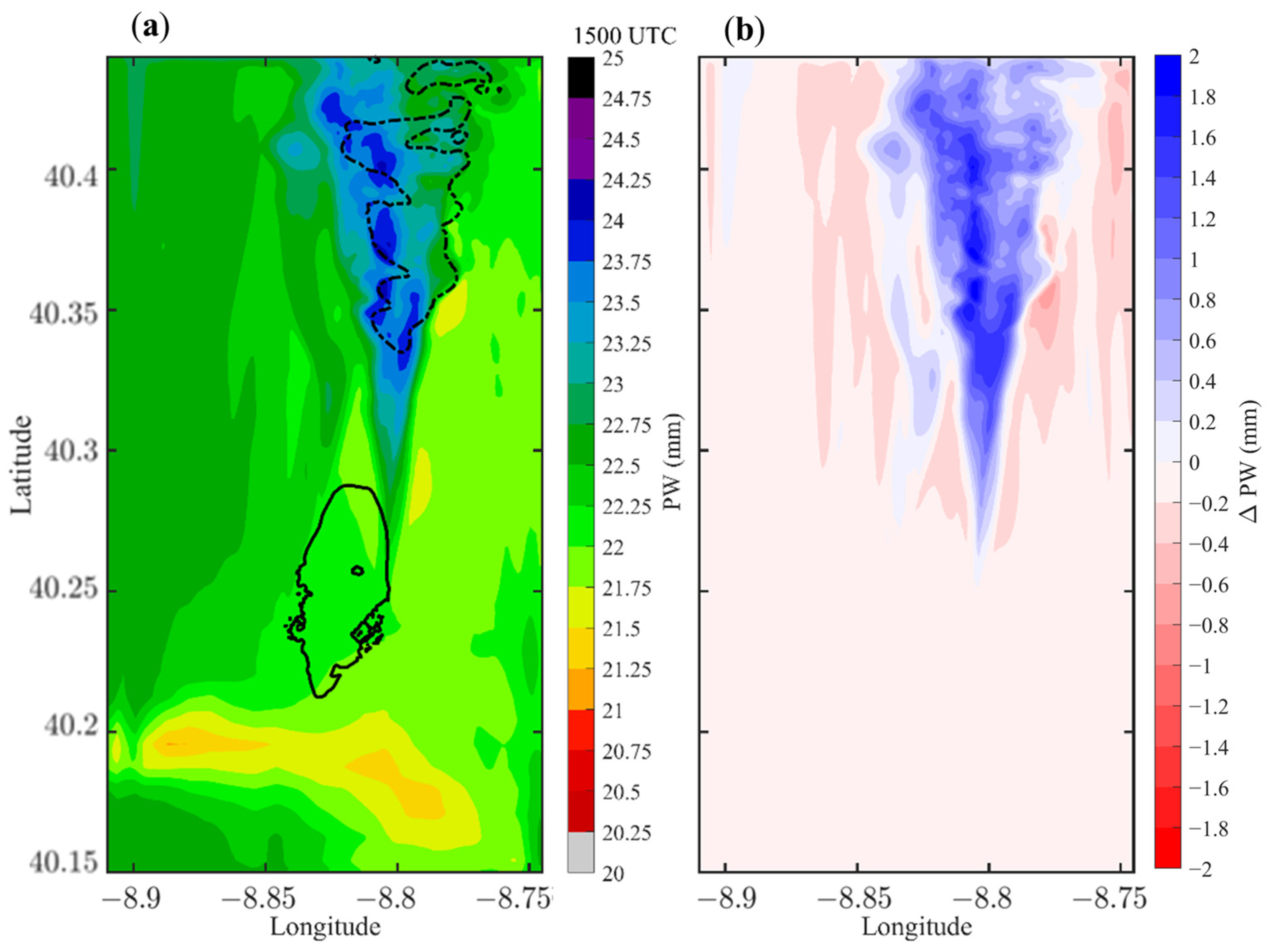
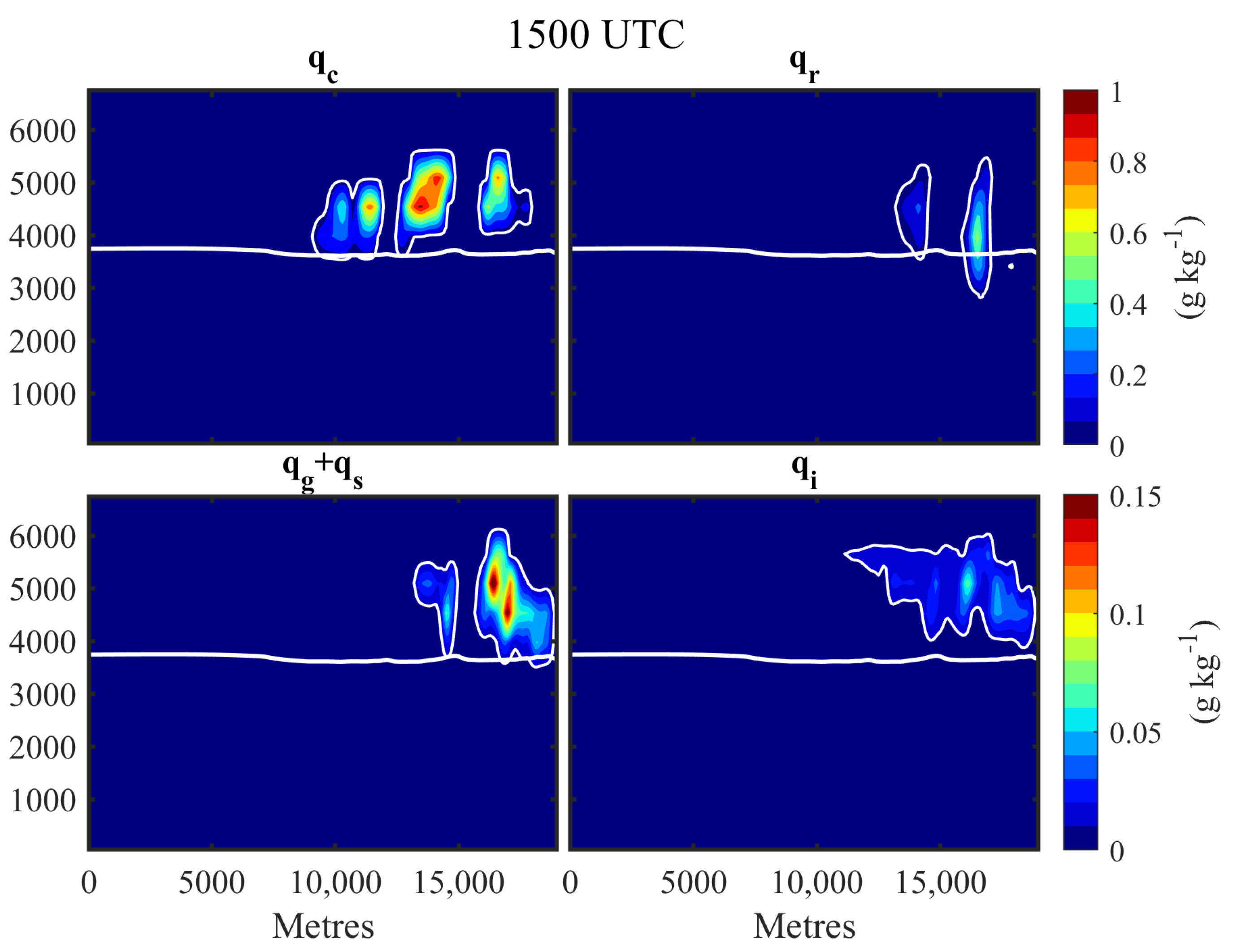

| d01-d03 | d04-LES | |
|---|---|---|
| Microphysics | WSM6 (6) | WSM6 (6) |
| Cumulus | Kain-Fritsch (1-d01;0-d01-03) | (0) |
| Longwave Radiation | RRTMG (4) | RRTMG (4) |
| Shortwave Radiation | RRTMG (4) | RRTMG (4) |
| Planetary Boundary Layer | YSU (1) | (0) |
| Surface Layer | Revised MM5 (1) | Revised MM5 (1) |
| Land Surface Model | Noah-MP (4) | Noah-MP (4) |
Disclaimer/Publisher’s Note: The statements, opinions and data contained in all publications are solely those of the individual author(s) and contributor(s) and not of MDPI and/or the editor(s). MDPI and/or the editor(s) disclaim responsibility for any injury to people or property resulting from any ideas, methods, instructions or products referred to in the content. |
© 2025 by the authors. Licensee MDPI, Basel, Switzerland. This article is an open access article distributed under the terms and conditions of the Creative Commons Attribution (CC BY) license (https://creativecommons.org/licenses/by/4.0/).
Share and Cite
Vaz, R.; Silva, R.; Cardoso Pereira, S.; Carvalho, A.C.; Carvalho, D.; Rocha, A. Coupled Atmosphere–Fire Modelling of Pyroconvective Activity in Portugal. Fire 2025, 8, 153. https://doi.org/10.3390/fire8040153
Vaz R, Silva R, Cardoso Pereira S, Carvalho AC, Carvalho D, Rocha A. Coupled Atmosphere–Fire Modelling of Pyroconvective Activity in Portugal. Fire. 2025; 8(4):153. https://doi.org/10.3390/fire8040153
Chicago/Turabian StyleVaz, Ricardo, Rui Silva, Susana Cardoso Pereira, Ana Cristina Carvalho, David Carvalho, and Alfredo Rocha. 2025. "Coupled Atmosphere–Fire Modelling of Pyroconvective Activity in Portugal" Fire 8, no. 4: 153. https://doi.org/10.3390/fire8040153
APA StyleVaz, R., Silva, R., Cardoso Pereira, S., Carvalho, A. C., Carvalho, D., & Rocha, A. (2025). Coupled Atmosphere–Fire Modelling of Pyroconvective Activity in Portugal. Fire, 8(4), 153. https://doi.org/10.3390/fire8040153











